A DOPO-Based Compound Containing Aminophenyl Silicone Oil for Reducing Fire Hazards of Polycarbonate
Abstract
:1. Introduction
2. Experimental
2.1. Synthesis of DASO
2.2. Preparation of FRPC Composites
3. Results and Discussion
3.1. Characterization of DASO
3.2. Thermal Stability of PC and FRPCs
3.3. Flame Retardancy Analysis
3.4. Cone Calorimeter Tests
3.5. Characterization of Char Residue
3.6. TGA-FTIR Analysis of Gaseous Products
3.7. Possible Flame Retardant Mechanism
3.8. Mechanical Properties
4. Conclusions
Supplementary Materials
Author Contributions
Funding
Institutional Review Board Statement
Informed Consent Statement
Data Availability Statement
Conflicts of Interest
References
- Bagotia, N.; Choudhary, V.; Sharma, D.K. Synergistic effect of graphene/multiwalled carbon nanotube hybrid fillers on mechanical, electrical and EMI shielding properties of polycarbonate/ethylene methyl acrylate nanocomposites. Compos. Part B Eng. 2019, 159, 378–388. [Google Scholar] [CrossRef]
- Liang, C.; Liu, S.; Wirasaputra, A.; Zhao, J.; Fu, Y. Light difusing and fame-retardant polycarbonate modifed by highly efcient and multifunctional organosilica microspheres. J. Therm. Anal. Calorim. 2021, 146, 2423–2433. [Google Scholar] [CrossRef]
- Shi, L.; Chew, M.Y. A review of fire processes modeling of combustible materials under external heat flux. Fuel 2013, 106, 30–50. [Google Scholar] [CrossRef]
- Wang, J.B.; Xin, Z. Flame Retardancy, Thermal, Rheological, and Mechanical Properties of Polycarbonate/Polysilsesquioxane System. J. Appl. Polym. Sci. 2010, 115, 330–337. [Google Scholar] [CrossRef]
- Li, Z.Q.; Yang, R.J. Flame retardancy, thermal and mechanical properties of sulfonate-containing polyhedral oligomeric silsesquioxane (S-POSS)/polycarbonate composite. Polym. Degrad. Stabil. 2015, 116, 81–87. [Google Scholar] [CrossRef]
- Wei, Y.-X.; Deng, C.; Zhao, Z.-Y.; Wang, Y.-Z. A novel organic-inorganic hybrid SiO2@DPP for the fire retardance of polycarbonate. Polym. Degrad. Stabil. 2018, 154, 177–185. [Google Scholar] [CrossRef]
- Feng, J.; Hao, J.; Du, J.; Yang, R. Flame retardancy and thermal properties of solid bisphenol A bis(diphenyl phosphate) combined with montmorillonite in polycarbonate. Polym. Degrad. Stabil. 2010, 95, 2041–2048. [Google Scholar] [CrossRef]
- Zhou, X.; Qiu, S.; Mu, X.; Zhou, M.; Cai, W.; Song, L.; Xing, W.; Hu, Y. Polyphosphazenes-based flame retardants: A review. Compos. B Eng. 2020, 202, 108397. [Google Scholar] [CrossRef]
- Xia, L.; Li, F.; Shentu, B.; Weng, Z. Thermal Degradation Behavior and Flame Retardancy of Polycarbonate Containing Poly[(phenylsilsesquioxane)-co-(dimethylsio-ane)] and Potassium Diphenyl Sulfonate. J. Macromol. Sci. Part B Phys. 2015, 52, 310–318. [Google Scholar] [CrossRef]
- Sai, T.; Ran, S.; Huo, S.; Guo, Z.; Song, P.; Fang, Z. Sulfonated Block Ionomers Enable Transparent, Fire-Resistant, Tough yet Strong Polycarbonate. Chem. Eng. J. 2022, 433, 133264. [Google Scholar] [CrossRef]
- Zhao, W.; Li, B.; Xu, M.; Yang, K.; Lin, L. Novel intumescent flame retardants: Synthesis and application in polycarbonate. Fire Mater. 2013, 37, 530–546. [Google Scholar] [CrossRef]
- Nguyen, C.; Kim, J. Thermal stabilities and flame retardancies of nitrogen-phosphorus flame retardants based on bisphosphoramidates. Polym. Degrad. Stabil. 2008, 93, 1037–1043. [Google Scholar] [CrossRef]
- Qian, Z.; Zou, B.; Xiao, Y.; Qiu, S.; Xu, Z.; Yang, Y.; Jiang, G.; Zhang, Z.; Song, L.; Hu, Y. Targeted modification of black phosphorus by MIL-53(Al) inspired by “Cannikin’s Law” to achieve high thermal stability of flame retardant polycarbonate at ultra-low additions. Compos. B Eng. 2022, 238, 109943. [Google Scholar] [CrossRef]
- Nabipour, H.; Wang, X.; Song, L.; Hu, Y. Metal-organic frameworks for flame retardant polymers application: A critical review. Compos. Part A Appl. Sci. Manuf. 2020, 139, 106113. [Google Scholar] [CrossRef]
- Qin, Y.; Li, M.; Huang, T.; Shen, C.; Gao, S. A study on the modification of polypropylene by a star-shaped intumescent flame retardant containing phosphorus and nitrogen. Polym. Degrad. Stabil. 2020, 195, 109801. [Google Scholar] [CrossRef]
- Zheng, T.; Wang, W.; Liu, Y. A novel phosphorus-nitrogen flame retardant for improving the flame retardancy of polyamide 6: Preparation, properties, and flame retardancy mechanism. Polym. Adv. Technol. 2021, 32, 2508–2516. [Google Scholar] [CrossRef]
- Zhao, W.; Li, B.; Xu, M.; Zhang, L.; Liu, F.; Guan, L. Synthesis of a Novel Flame Retardant Containing Phosphorus and Sulfur and Its Application in Polycarbonate. Polym. Eng. Sci. 2012, 52, 2327–2335. [Google Scholar] [CrossRef]
- Xu, M.; Zhao, W.; Li, B.; Yang, K.; Lin, L. Synthesis of a phosphorus and sulfur-containing aromatic diamine curing agent and its application in flame retarded epoxy resins. Fire Mater. 2015, 39, 518–532. [Google Scholar] [CrossRef]
- Niu, Q.; Yue, X.; Guo, Z.; Yan, H.; Fang, Z.; Li, J. Flame retardant bamboo fiber reinforced polylactic acid composites regulated by interfacial phosphorus-silicon aerogel. Polymer 2022, 252, 124961. [Google Scholar] [CrossRef]
- Luo, X.; Hu, H.; Ma, J.; Huang, Y.; Yang, J. Synthesis and characterization of dicyclic silicon-/phosphorus-grafted alumina and its application in improving flame retardancy of epoxy resin. J. Appl. Polym. Sci. 2021, 138, 49854. [Google Scholar] [CrossRef]
- Jiang, G.; Xiao, Y.; Qian, Z.; Yang, Y.; Jia, P.; Song, L.; Hu, Y.; Ma, C.; Gui, Z. A novel phosphorus-, nitrogen- and sulfur-containing macromolecule flame retardant for constructing high-performance epoxy resin composites. Chem. Eng. J. 2022, 451, 137823. [Google Scholar] [CrossRef]
- Li, W.; Dou, Y.; Li, X.; Fang, S.; Li, J.; Li, Q. A Highly Effective, UV-Curable, Intumescent, Flame-Retardant Coating Containing Phosphorus, Nitrogen, and Sulfur, Based on Thiol-Ene Click Reaction. Materials 2022, 15, 3358. [Google Scholar] [CrossRef] [PubMed]
- Chen, Y.J.; Wu, X.D.; Qian, L.J. Flame-retardant behavior and protective layer effect of phosphazene-triazine bi-group flame retardant on polycarbonate. J. Appl. Polym. Sci. 2020, 137, 49523. [Google Scholar] [CrossRef]
- Yang, H.; Yue, H.; Zhao, X.; Song, M.; Guo, J.; Cui, Y.; Fernández-Blázquez, J.P.; Wang, D.-Y. Polycarbonate/Sulfonamide Composites with Ultralow Contents of Halogen-Free Flame Retardant and Desirable Compatibility. Materials 2020, 13, 3656. [Google Scholar] [CrossRef] [PubMed]
- Hu, Z.; Chen, L.; Zhao, B.; Luo, Y.; Wang, D.-Y.; Wang, Y.-Z. A novel efficient halogen-free flame retardant system for polycarbonate. Polym. Degrad. Stabil. 2011, 96, 320–327. [Google Scholar] [CrossRef]
- Wang, Z.; Yonggang, L.; Huijuan, M.; Wenpeng, S.; Tao, L.; Cuifen, L.; Junqi, N.; Guichun, Y.; Zuxing, C. Novel phosphorus-nitrogen-silicon copolymers with double-decker silsesquioxane in the main chain and their flame retardancy application in PC/ABS. Fire Mater. 2018, 42, 946–957. [Google Scholar] [CrossRef]
- Wei, Y.-X.; Deng, C.; Wei, W.-C.; Chen, H.; Wang, Y.-Z. Hybrid Nanorods Comprised of Titanium, Silicon, and Organophosphorus as Additives for Flame-Retardant Polycarbonate. ACS. Appl. Nano. Mater. 2019, 2, 4859–4868. [Google Scholar] [CrossRef]
- Wan, Y.; Yu, S.; Jiang, S.; Pei, Q.; Xu, S.; Cao, W.; Liu, X.; Lan, Y. Microscopic pyrolysis mechanism on the octyphenylsiloxane flame retarded polycarbonate by reactive molecular dynamics. J. Anal. Appl. Pyrol. 2021, 158, 105274. [Google Scholar] [CrossRef]
- Wang, P.; Yang, F.; Li, L.; Cai, Z. Flame retardancy and mechanical properties of epoxy thermosets modified with a novel DOPO-based oligomer. Polym. Degrad. Stabil. 2016, 129, 156–167. [Google Scholar] [CrossRef]
- Yang, Y.; Chen, W.; Li, Z.; Huang, G.; Wu, G. Efficient flame retardancy, good thermal stability, mechanical enhancement, and transparency of DOPO-conjugated structure compound on epoxy resin. Chem. Eng. J. 2022, 450, 138424. [Google Scholar] [CrossRef]
- Yang, R.; Gu, G.; Tang, C.; Miao, Z.; Cao, H.; Zou, G.; Li, J. Super-tough and flame-retardant poly(lactic acid)materials using a phosphorus-containing malic acid-based copolyester by reactive blending. Polym. Degrad. Stabil. 2022, 198, 109889. [Google Scholar] [CrossRef]
- Zhu, Y.; Yu, R.; Wang, S.; Xing, H.; Qiu, J.; Liu, J.; Tang, T. Unexpected core-shell char from polycarbonate/polyborosiloxane composites and its application in improving flame retardancy. Chem. Eng. J. 2022, 446, 136742. [Google Scholar] [CrossRef]
- Attia, N.F.; Park, J.; Oh, H. Facile tool for green synthesis of graphene sheets and their smart freestanding UV protective film. Appl. Surf. Sci. 2018, 458, 425–430. [Google Scholar] [CrossRef]
- Wu, X.; Qin, Z.; Zhang, W.; Yang, R. KCl nanoparticles-loaded octaphenylsilsesquioxane as an efficient flame retardant for polycarbonate. React. Funct. Polym. 2022, 177, 105284. [Google Scholar] [CrossRef]
- Sai, T.; Su, Y.; Shen, H.; Ran, S.; Huo, S.; Guo, Z.; Fang, Z. Fabrication and Mechanism Study of Cerium-Based P, N-Containing Complexes for Reducing Fire Hazards of Polycarbonate with Superior Thermostability and Toughness. ACS Appl. Mater. Interfaces 2021, 13, 30061–30075. [Google Scholar] [CrossRef]
- Weil, E.D.; Levchik, S. A review of current flame retardant systems for epoxy resins. J. Fire Sci. 2004, 22, 25–40. [Google Scholar] [CrossRef]
- Qian, L.-J.; Ye, L.-J.; Xu, G.-Z.; Liu, J.; Guo, J.-Q. The non-halogen flame retardant epoxy resin based on a novel compound with phosphaphenanthrene and cyclotriphosphazene double functional groups. Polym. Degrad. Stabil. 2011, 96, 1118–1124. [Google Scholar] [CrossRef]
- Sai, T.; Ran, S.; Guo, Z.; Yan, H.; Zhang, Y.; Wang, H.; Song, P.; Fang, Z. Transparent, highly thermostable and flame retardant polycarbonate enabled by rod-like phosphorous-containing metal complex aggregates. Chem. Eng. J. 2021, 409, 128223. [Google Scholar] [CrossRef]
- Wang, H.; Li, S.; Zhu, Z.; Yin, X.; Wang, L.; Weng, Y.; Wang, X. A novel DOPO-based flame retardant containing benzimidazolone structure with high charring ability towards low flammability and smoke epoxy resins. Polym. Degrad. Stabil. 2021, 183, 109426. [Google Scholar] [CrossRef]

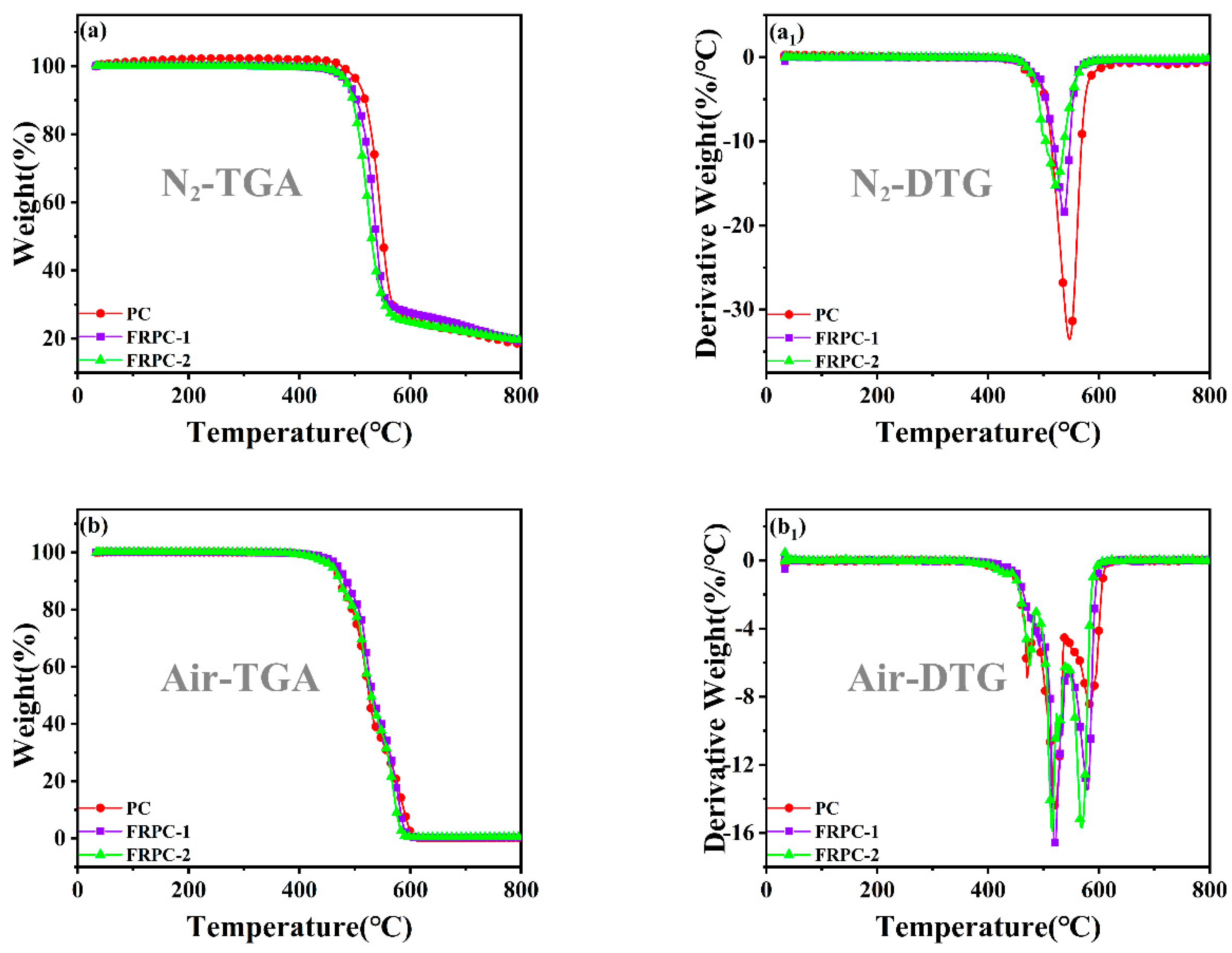
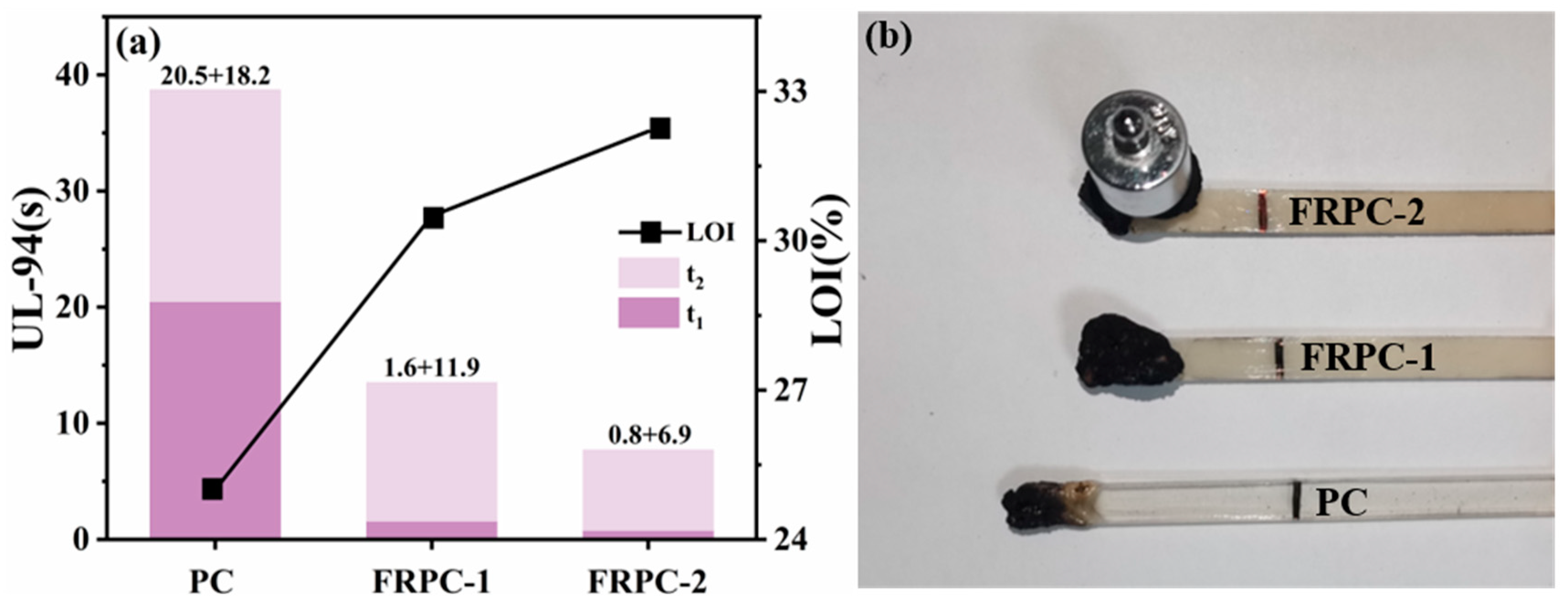
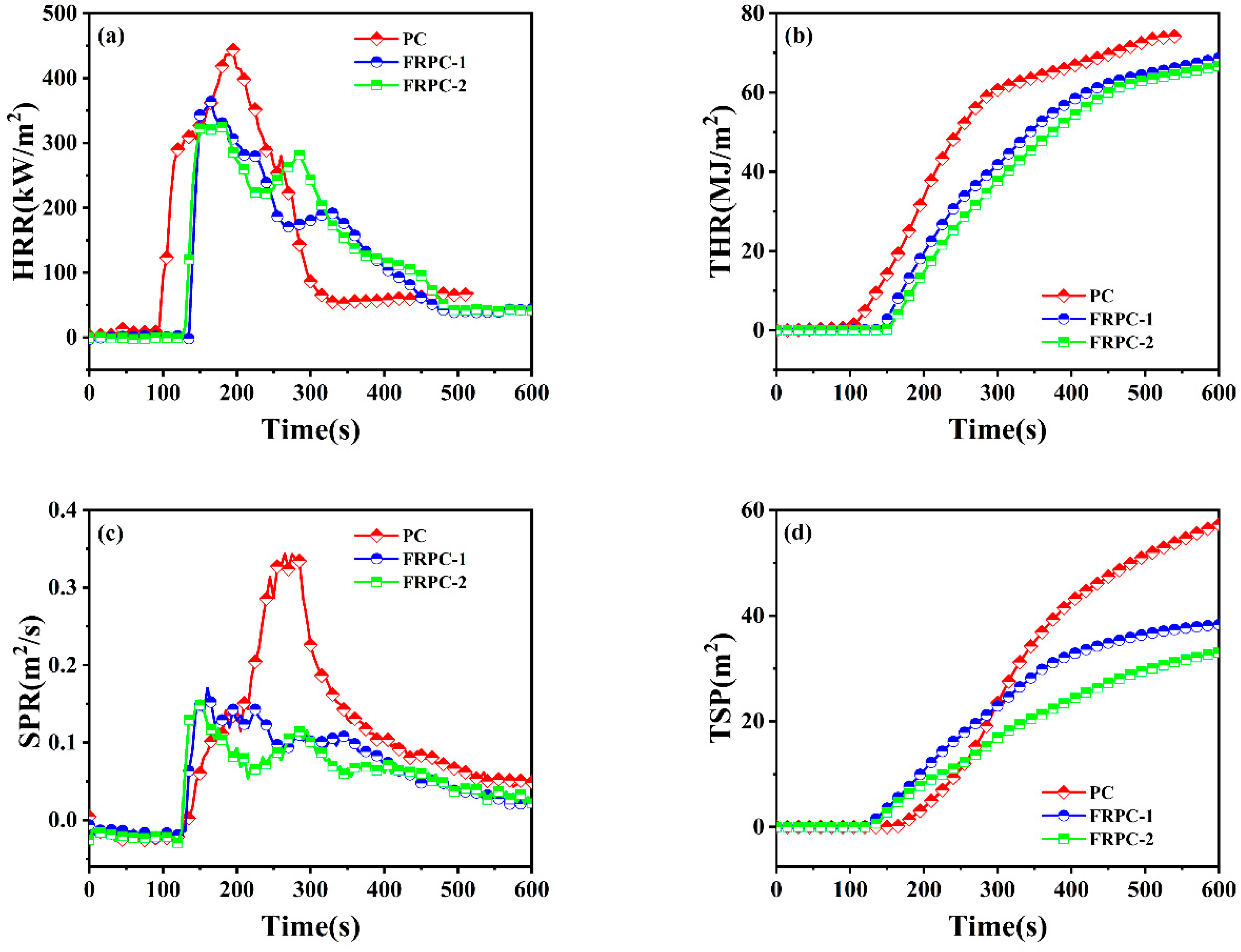

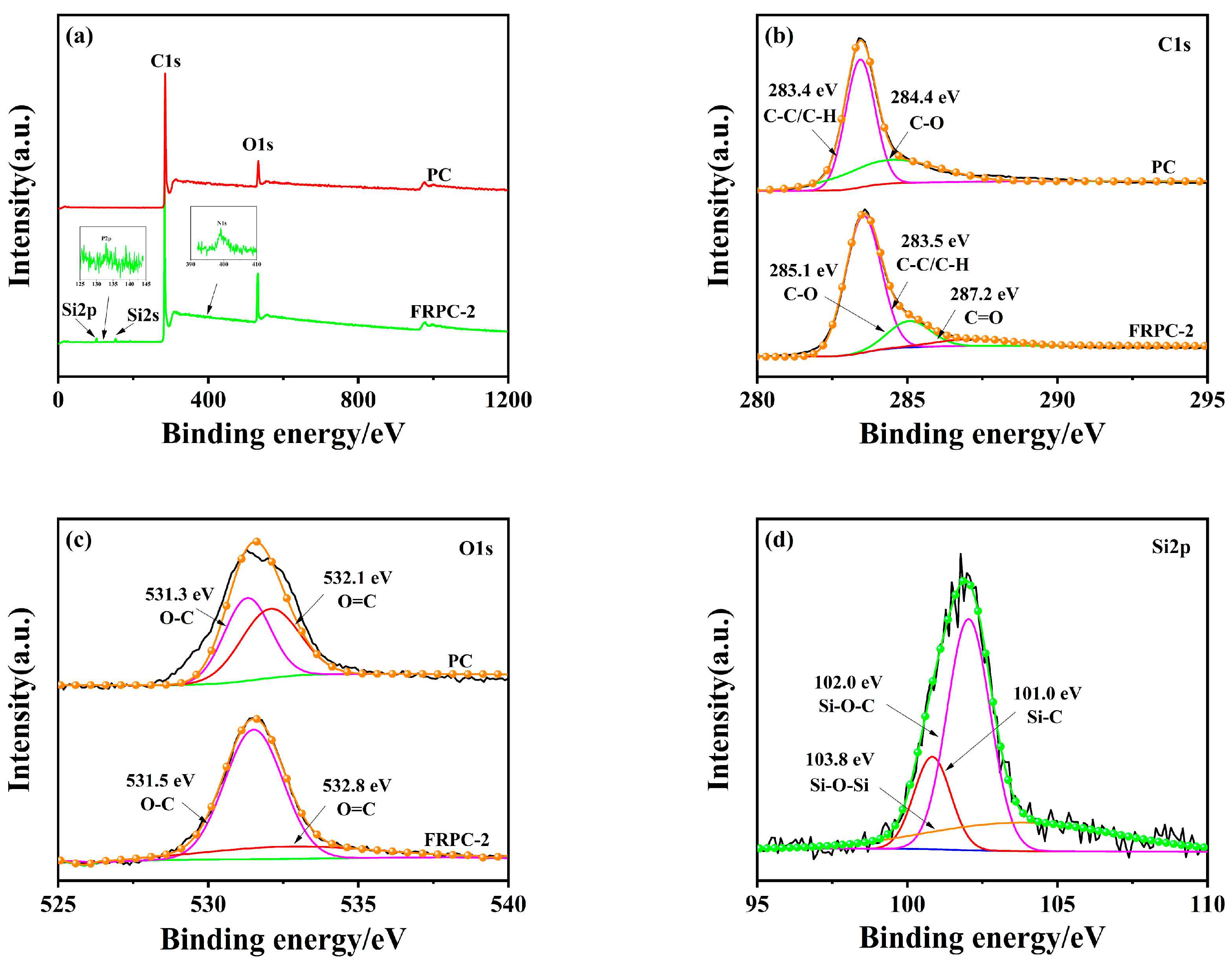
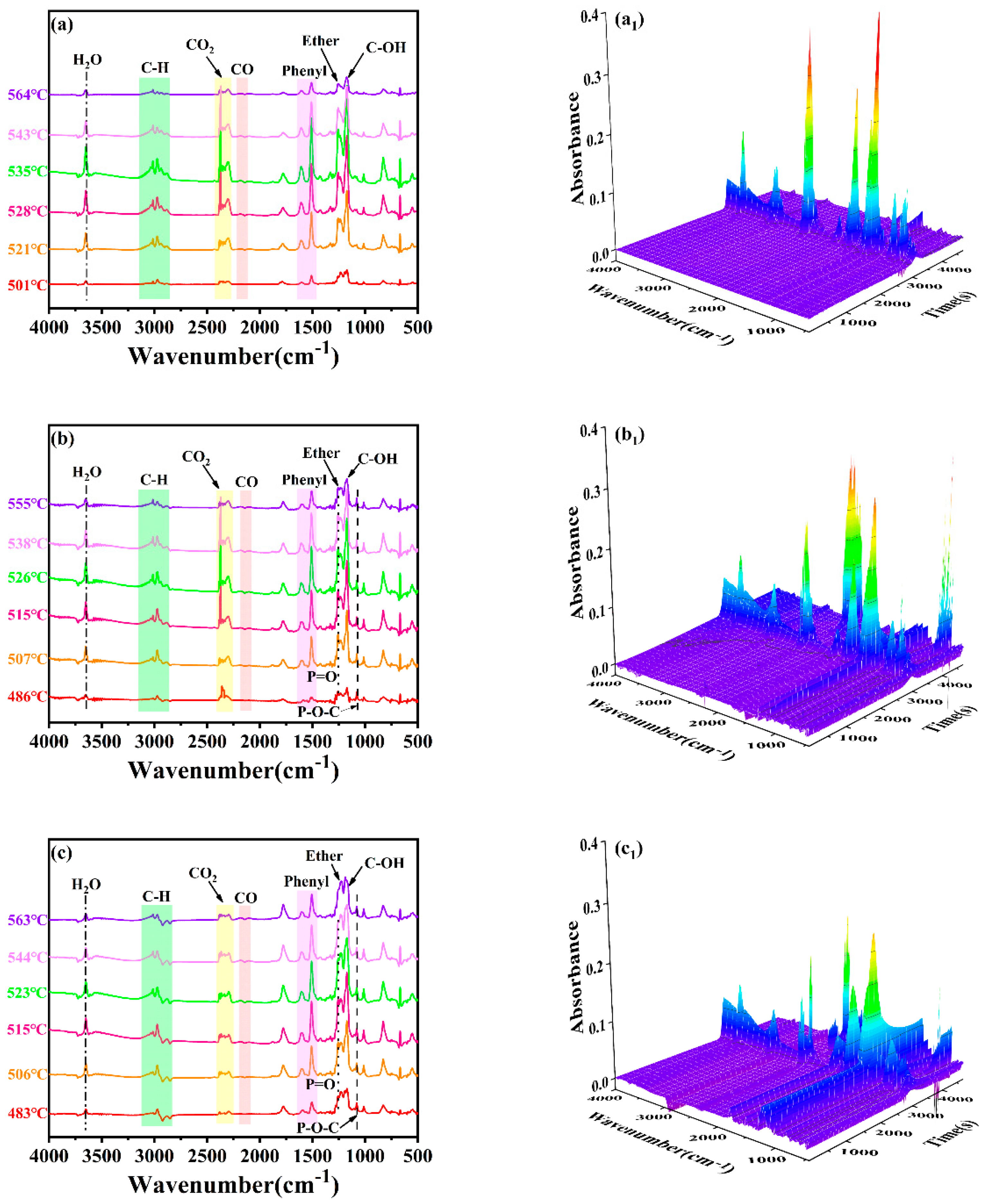
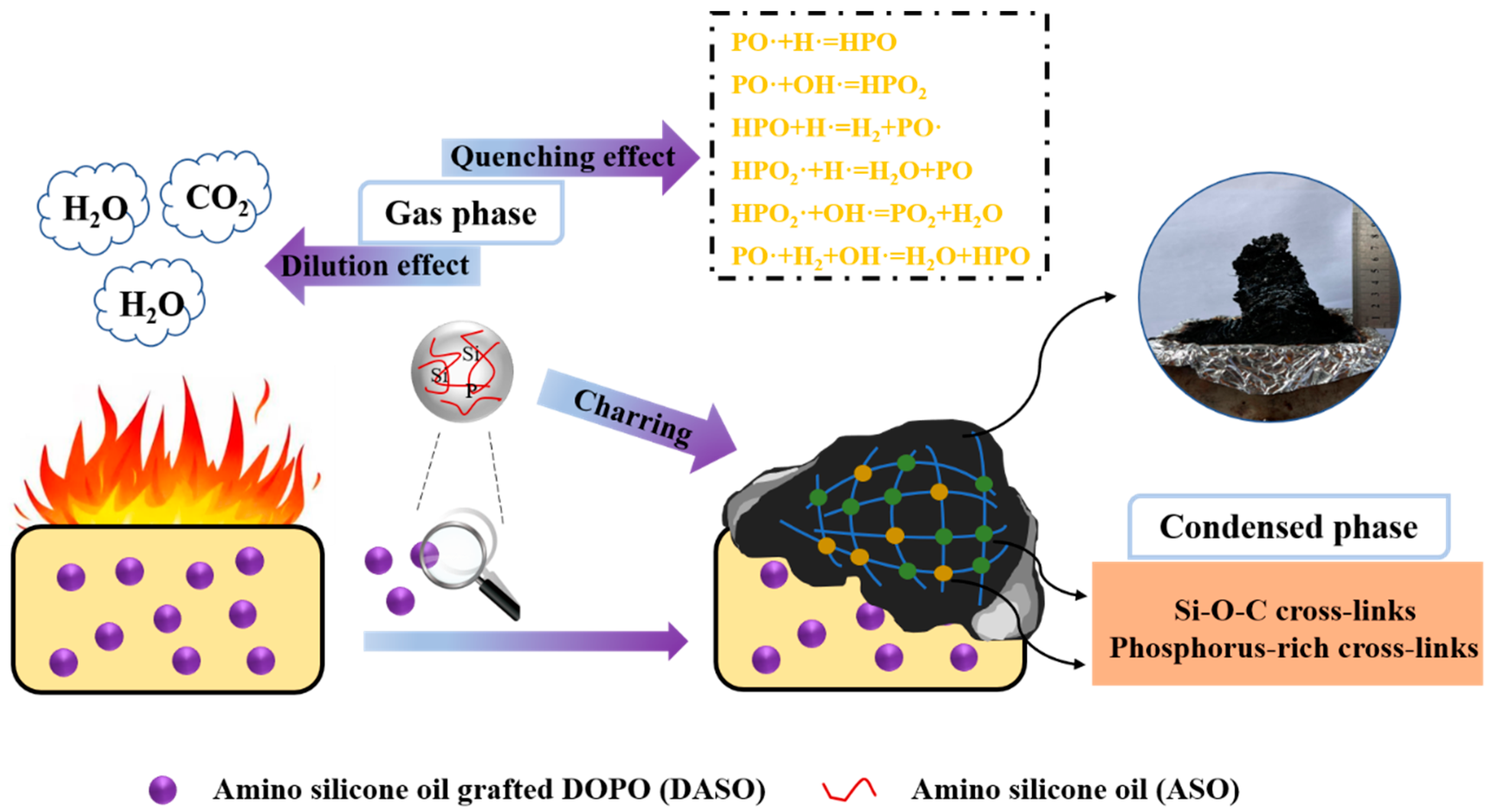

| Sample | PC (wt%) | DASO (wt%) |
|---|---|---|
| PC | 100 | 0 |
| FRPC-1 | 99 | 1 |
| FRPC-2 | 98 | 2 |
| Specimen | Nitrogen | Air | |||||||
|---|---|---|---|---|---|---|---|---|---|
| T5% (°C) | Tmax (°C) | Rmax (%/min) | CY800 (wt%) | T5% (°C) | Tmax1 (°C) | Tmax2 (°C) | Tmax3 (°C) | CY800 (wt%) | |
| PC | 507 | 549 | 33.4 | 18.4 | 474 | 481 | 522 | 593 | 0.18 |
| FRPC-1 | 488 | 537 | 19.2 | 19.2 | 469 | 471 | 520 | 579 | 0.41 |
| FRPC-2 | 486 | 523 | 15.5 | 19.6 | 459 | 475 | 517 | 569 | 0.55 |
| Sample | PC | FRPC-1 | FRPC-2 |
|---|---|---|---|
| TTI (s) | 150 | 130 | 123 |
| PHRR (kW/m2) | 443.5 | 364.0 | 326.1 |
| t-PHRR (s) | 195 | 165 | 160 |
| THR (MJ/m2) | 74.2 | 72.9 | 70.2 |
| TSP (m2) | 63.4 | 39.6 | 35.4 |
| PSPR | 0.34 | 0.17 | 0.15 |
| av-COY (kg/kg) | 0.10 | 0.12 | 0.13 |
| av-CO2Y (kg/kg) | 1.73 | 1.74 | 1.68 |
| av-EHC (MJ/kg) | 24.9 | 22.8 | 20.4 |
| Char residue(%) | 13.5 | 13.6 | 13.9 |
| FIGRA (kW/m2·s) | 2.27 | 2.21 | 2.04 |
| Sample | C (At%) | O (At%) | Si (At%) | N(At%) | P (At%) |
|---|---|---|---|---|---|
| PC | 89.80 | 10.20 | 0 | 0 | 0 |
| FRPC-2 | 83.65 | 12.64 | 2.20 | 1.25 | 0.26 |
| Sample | PC | FRPC-1 | FRPC-2 |
|---|---|---|---|
| Tensile strength (MPa) | 60.3 ± 0.8 | 57.6 ± 1.4 | 54.3 ± 0.5 |
| Elongation at break (%) | 87.6 ± 2.9 | 85.9 ± 4.9 | 83.0 ± 5.3 |
| Impact strength (KJ/m2) | 68.9 ± 1.2 | 60.3 ± 0.9 | 57.2 ± 0.6 |
Disclaimer/Publisher’s Note: The statements, opinions and data contained in all publications are solely those of the individual author(s) and contributor(s) and not of MDPI and/or the editor(s). MDPI and/or the editor(s) disclaim responsibility for any injury to people or property resulting from any ideas, methods, instructions or products referred to in the content. |
© 2023 by the authors. Licensee MDPI, Basel, Switzerland. This article is an open access article distributed under the terms and conditions of the Creative Commons Attribution (CC BY) license (https://creativecommons.org/licenses/by/4.0/).
Share and Cite
Song, X.; Xu, W.; Cai, B.; Wang, L.; Luo, Z.; Wang, B. A DOPO-Based Compound Containing Aminophenyl Silicone Oil for Reducing Fire Hazards of Polycarbonate. Materials 2023, 16, 1449. https://doi.org/10.3390/ma16041449
Song X, Xu W, Cai B, Wang L, Luo Z, Wang B. A DOPO-Based Compound Containing Aminophenyl Silicone Oil for Reducing Fire Hazards of Polycarbonate. Materials. 2023; 16(4):1449. https://doi.org/10.3390/ma16041449
Chicago/Turabian StyleSong, Xiaoqing, Wendi Xu, Boyu Cai, Luze Wang, Zhonglin Luo, and Biaobing Wang. 2023. "A DOPO-Based Compound Containing Aminophenyl Silicone Oil for Reducing Fire Hazards of Polycarbonate" Materials 16, no. 4: 1449. https://doi.org/10.3390/ma16041449
APA StyleSong, X., Xu, W., Cai, B., Wang, L., Luo, Z., & Wang, B. (2023). A DOPO-Based Compound Containing Aminophenyl Silicone Oil for Reducing Fire Hazards of Polycarbonate. Materials, 16(4), 1449. https://doi.org/10.3390/ma16041449






